How To make Khao Niew Dam - Black Sticky Rice With Coconut Cream
Khao Niew Dam, or black sticky rice with coconut cream, is a cherished Southeast Asian dessert with centuries of cultural significance. You’ll need to soak black sticky rice overnight, steam it until tender, then serve with a sweet coconut sauce made from coconut milk, sugar, and salt. The dish offers a perfect balance of chewy textures and sweet-savory flavors, while providing more protein and fiber than white rice. This comforting treat reveals the heart of traditional Thai cuisine with every spoonful.
Key Takeaways
- Khao Niew Dam is a traditional Southeast Asian dessert combining black sticky rice with sweet coconut cream sauce.
- The rice requires soaking for at least 4 hours or overnight before steaming for 25-30 minutes until tender but chewy.
- The coconut sauce is made by heating coconut milk with sugar and salt until dissolved.
- This nutritious dessert contains more protein, fiber, and antioxidants than white rice varieties.
- It balances sweet and savory flavors while holding cultural significance in Thailand, Laos, and surrounding regions.
History
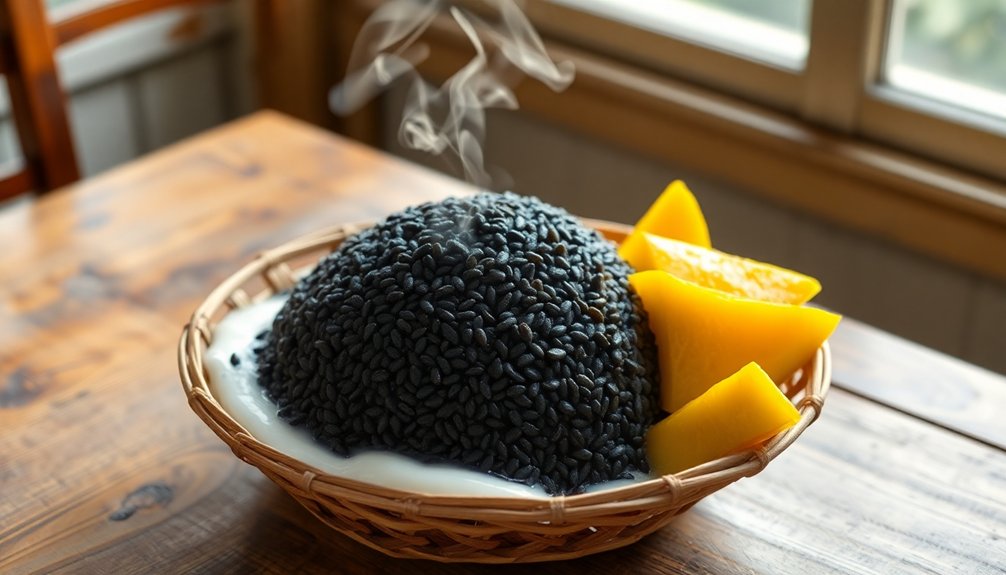
Though its precise origins remain somewhat obscured by time, Khao Niew Dam (Black Sticky Rice) has been cultivated in Southeast Asia for thousands of years, particularly in regions spanning modern-day Thailand, Laos, and parts of southern China.
You’ll find this grain deeply woven into the cultural significance of these societies, often appearing in ceremonies celebrating harvests, fertility, and ancestral reverence.
Unlike its white counterpart, black sticky rice was historically reserved for nobility and special occasions due to its rarity and distinctive properties.
Its traditional origins trace back to ancient agricultural practices where farmers noticed its resilience to certain environmental conditions.
Today, you’re enjoying a dessert that was once considered a luxury, symbolizing the evolution of a food that transcended its status as mere sustenance to become a celebrated cultural touchstone.
Recipe
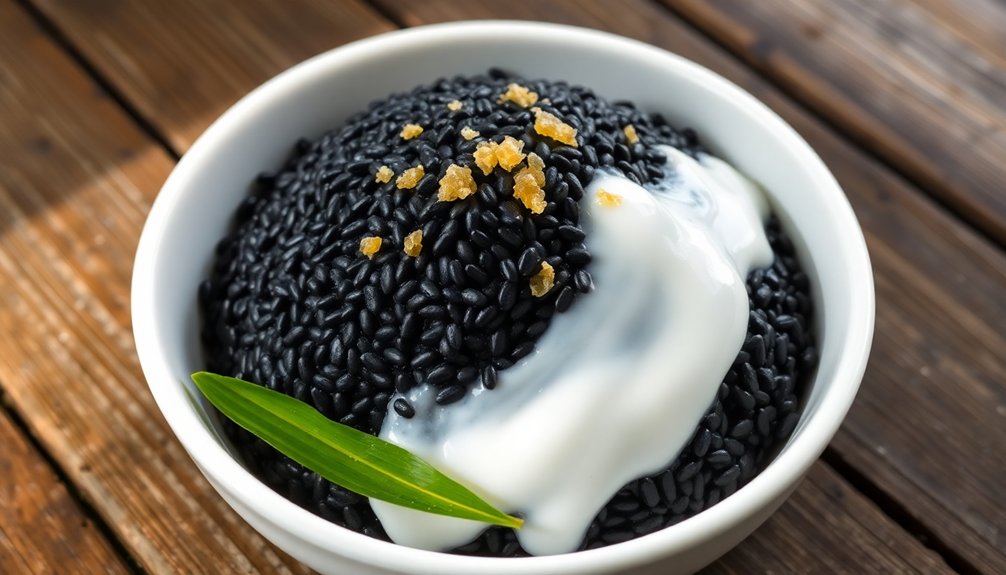
- Rinse 2 cups of black sticky rice in cold water until water runs clear.
- Soak the rice for at least 4 hours or overnight.
- Drain the soaked rice.
- Line a steamer basket with cheesecloth or a clean kitchen towel.
- Spread the rice evenly in the basket.
- Fill the steamer pot with water, ensuring it doesn’t touch the rice.
- Steam for 25-30 minutes until rice is tender but still chewy.
- While rice is cooking, prepare sweet coconut sauce by heating 1 cup coconut milk with 1/2 cup sugar and 1/2 teaspoon salt until sugar dissolves.
- Transfer cooked rice to a bowl and pour half the coconut sauce over it.
- Let stand for 15 minutes to absorb the flavors.
- Serve warm with remaining coconut sauce on the side.
- Garnish with sliced mango or toasted sesame seeds if desired.
Cooking Steps
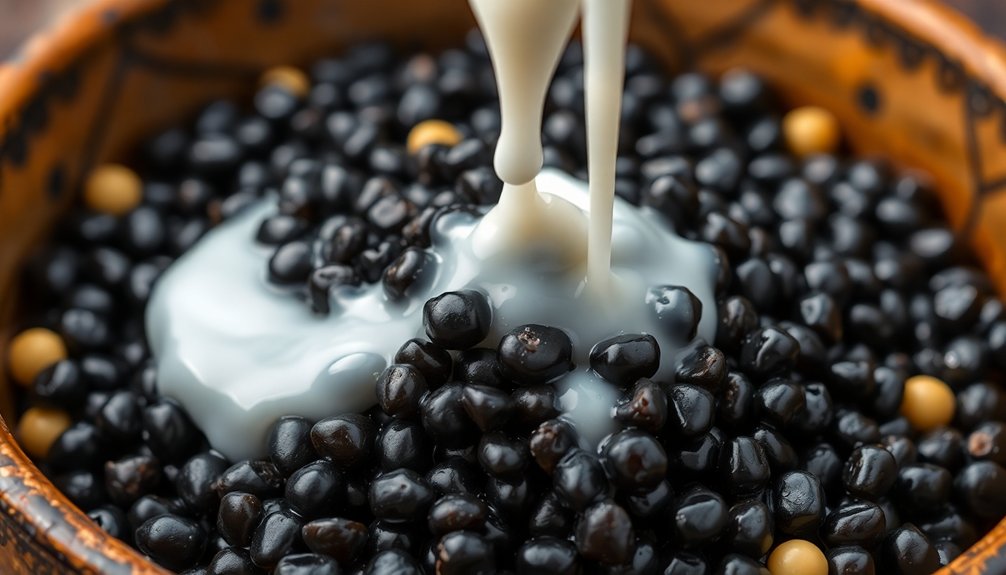
To prepare authentic Khao Niew Dam, you’ll need to begin by soaking the black sticky rice overnight to soften the firm outer bran.
You’ll then steam the rice until it’s perfectly tender before carefully incorporating a sweetened coconut cream mixture that balances the rice’s nutty flavor.
For the finishing touch, you’ll sprinkle toasted sesame seeds across the top, adding both visual appeal and a subtle crunch to this traditional Thai dessert.
step 1. Soak Rice Overnight
Soaking the black sticky rice overnight stands as the vital first step in the traditional preparation of Khao Niew Dam.
You’ll need to place the rice in a large bowl and cover it completely with cold water, ensuring at least two inches of water sits above the grain level. Different rice varieties require varying soaking techniques—Thai black sticky rice typically needs 6-8 hours, while some heirloom varieties might benefit from up to 12 hours.
During this soaking period, the rice absorbs moisture, softening its outer hull and reducing cooking time considerably.
You’ll notice the water darkening to a deep purple hue as anthocyanins release from the grain. This process not only hydrates the starches but also activates enzymes that improve digestibility.
Don’t skip this vital step—properly soaked rice yields the perfect chewy texture that defines authentic Khao Niew Dam.
step 2. Steam Rice Until Tender
Proper steaming transforms the soaked black sticky rice into the wonderfully chewy delicacy that’s Khao Niew Dam.
After draining your overnight-soaked rice, place it in a bamboo steamer lined with cheesecloth or a fine-mesh cotton bag. The traditional conical Thai steamer (huad) works best, but any bamboo steamer will suffice.
Steam the rice over rapidly boiling water for 25-30 minutes, depending on the rice varieties used. Thai black glutinous rice typically requires longer steaming than other sticky rice types.
You’ll know it’s done when the grains are tender but still maintain their distinct texture. Different steaming techniques affect the final consistency—keep the lid tightly closed throughout to trap steam effectively.
Halfway through, gently flip the rice to guarantee even cooking. The grains should be soft yet separate, not mushy or clumped together.
step 3. Prepare Coconut Cream Mixture
While your perfectly steamed black sticky rice rests, it’s time to prepare the coconut cream mixture that will transform the nutty grains into a luxurious dessert.
In a small saucepan over medium heat, combine 1 cup of coconut cream with 3 tablespoons of sugar and ¼ teaspoon of salt. Stir continuously until the sugar dissolves completely, about 2-3 minutes.
Don’t let the mixture boil, as this can cause separation.
The ideal coconut cream for rice pairing should be silky and not too thick—you want it to permeate the glutinous grains without overwhelming them.
For an aromatic dimension, add a pandanus leaf or ½ teaspoon of vanilla extract. This creamy element creates the perfect counterpoint to the earthy black rice, balancing its robust texture with velvety sweetness.
step 4. Add Sugar Mixture Carefully
The meticulous addition of your sugar mixture to the black sticky rice demands careful attention, as this step greatly impacts the final texture and sweetness distribution.
Pour your prepared sugar solution gradually while stirring continuously with a wooden spoon, ensuring even incorporation throughout the rice.
For authentic flavor profiles, consider using palm sugar or coconut sugar rather than refined white sugar, as they impart caramel notes that complement the nutty characteristics of black rice.
Employ gentle folding mixing techniques rather than vigorous stirring to prevent breaking the delicate rice grains while still achieving complete dissolution of the sugar crystals.
You’ll notice the mixture thickening slightly as the sugar integrates.
Stop adding sugar when you’ve reached your desired sweetness level, remembering that the coconut cream will contribute additional sweetness to the final dish.
step 5. Garnish With Sesame Seeds
Three distinct types of sesame seeds—black, white, or toasted—can elevate your khao niew dam from ordinary to visually striking. When your black sticky rice is complete in its serving dish, sprinkle 1-2 teaspoons of seeds across the top, focusing on the coconut cream layer for maximum contrast.
The tiny seeds add more than aesthetic appeal—they deliver a gentle crunch and nutty flavor that complements the rice’s sweetness. Sesame benefits extend beyond taste, offering calcium, antioxidants, and healthy oils that enhance the dessert’s nutritional profile.
For advanced garnish techniques, try creating patterns with the seeds or combining types for textural variety. Toast raw seeds in a dry pan for 2-3 minutes until fragrant to intensify flavor.
Cooking Tips
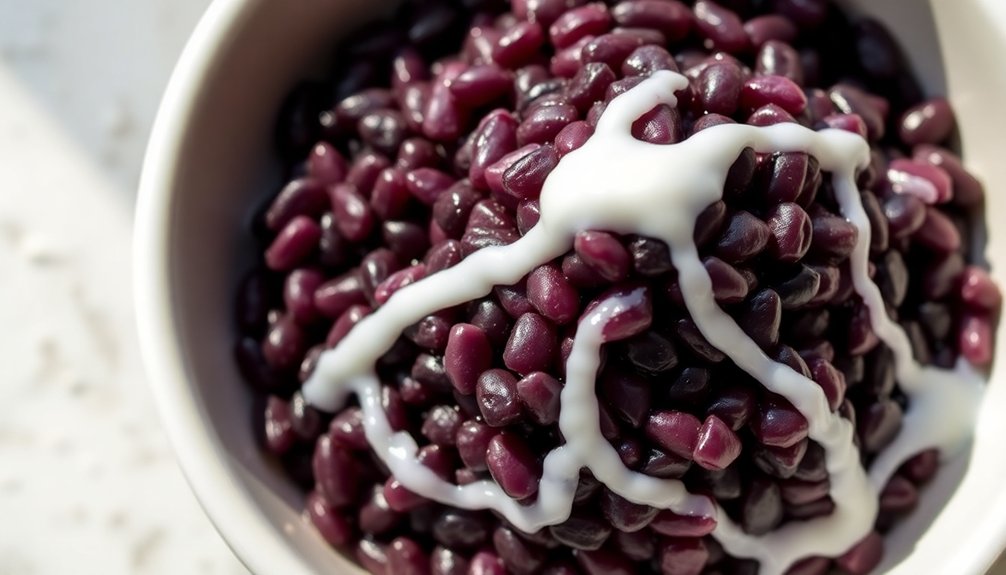
Achieving perfect khao niew dam requires attention to specific techniques that maintain its distinctive texture and enhance its natural nuttiness.
Don’t rush the soaking process—allow the grains to absorb water for at least 4 hours, preferably overnight, which softens the bran layer and guarantees even cooking throughout.
When steaming, avoid the temptation to lift the lid frequently as this releases essential steam.
If you’re struggling with sticky results, try the finger test: press the cooked rice gently—it should yield slightly but spring back.
For ingredient substitutions, brown sugar can replace palm sugar, though you’ll lose some caramel notes.
Similarly, you can substitute light coconut milk blended with coconut cream if you can’t find traditional coconut milk.
Final Thoughts
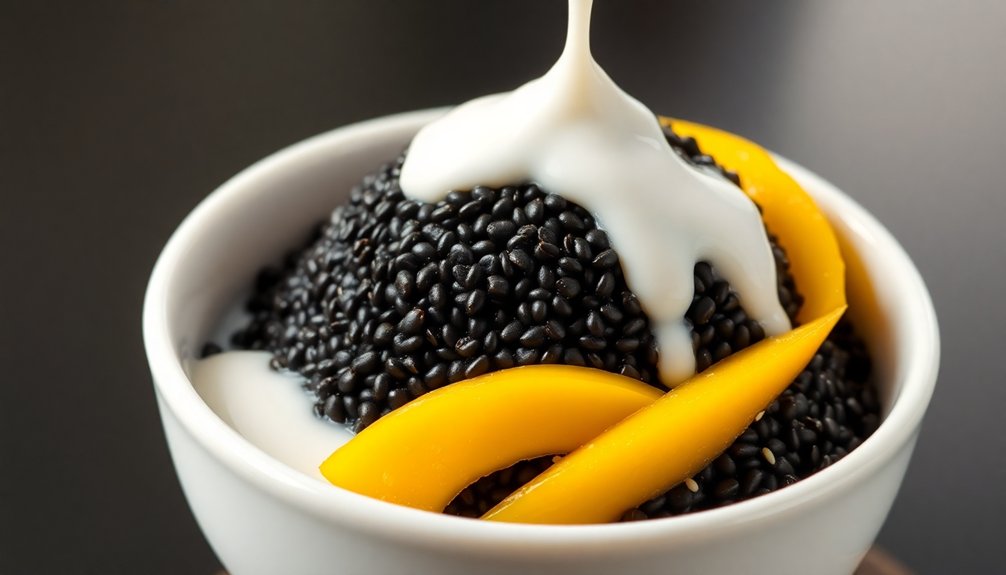
Though often overlooked in Western cuisine, khao niew dam stands as a demonstration to the rice diversity found throughout Southeast Asia. This versatile dish bridges the gap between dessert and staple food while offering numerous health benefits through its antioxidant-rich ingredients.
- Black sticky rice contains more protein and fiber than white rice varieties, making it a nutritionally superior option.
- Its cultural significance extends beyond Thailand into Laos, Myanmar, and parts of China where it’s served during celebrations.
- You’ll find the balance of coconut cream and black rice creates a textural experience that’s both comforting and distinctive.
- When prepared properly, this dish represents the perfect harmony between sweet and savory that characterizes much of Southeast Asian cuisine.
Frequently Asked Questions
Is Khao Niew Dam Gluten-Free?
Picture steaming grains nestled in bamboo baskets. Yes, you’re in luck! Khao niew dam is naturally gluten-free, offering digestive benefits. Among khao niew varieties, this black sticky rice maintains its gluten-free integrity.
How Long Does Black Sticky Rice Stay Fresh?
For ideal black sticky rice shelf life, you’ll get 2-3 days refrigerated or up to 6 months frozen. Proper black sticky storage in airtight containers prevents moisture loss and maintains its distinctive texture and flavor.
Can I Make Khao Niew Dam in a Rice Cooker?
While you might worry about texture, you can absolutely make khao niew dam in a rice cooker. Soak your black sticky rice first, then use a 1:2 rice-to-water ratio for best results. Essential cooking tip: stir halfway through.
Is Black Sticky Rice Healthier Than Regular Sticky Rice?
Black sticky rice offers more nutritional benefits than regular sticky rice, containing higher antioxidant levels, fiber, and protein. Your cooking methods won’t affect these advantages, regardless of preparation technique.
What Desserts Pair Well With Khao Niew Dam?
Imagine eating a spoonful of tropical paradise. You’ll find delightful dessert pairings with fresh fruits like mango or durian creating vibrant flavor combinations. Try coconut ice cream or Thai custard for complementary textures.
